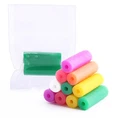Hey there! As an impression tray supplier, I often get asked a bunch of questions about the different uses of our products. One question that pops up quite a bit is, "Can an impression tray be used for partial denture impressions?" Well, let's dive right into it and find out.
First off, let's understand what partial dentures are. Partial dentures are used when a patient has some natural teeth remaining in their mouth. They're designed to fill in the gaps left by missing teeth and help with chewing and speaking. To make a perfect - fitting partial denture, an accurate impression of the patient's mouth is crucial.
Now, let's talk about impression trays. We offer a variety of impression trays, like Dental Implant Impression Trays, Disposable Impression Trays, and Dental Impression Trays. Each type has its own features and is designed for specific purposes.
The short answer to whether an impression tray can be used for partial denture impressions is yes, but there are some things to consider.
Types of Impression Trays for Partial Dentures
- Stock Impression Trays: These are the most common type you'll find. They come in standard sizes and shapes. They're a cost - effective option, but they might not fit every patient's mouth perfectly. For partial denture impressions, a stock tray can work, but you may need to do some modifications. You might have to trim the edges to ensure it doesn't interfere with the remaining natural teeth or the soft tissues in the mouth.
- Custom Impression Trays: These are made specifically for a patient's mouth. They offer a better fit compared to stock trays. When making partial denture impressions, a custom tray can capture all the details accurately. However, they take more time and effort to make. First, a preliminary impression is taken using a stock tray, and then a custom tray is fabricated based on that impression.
Advantages of Using an Impression Tray for Partial Denture Impressions
- Accuracy: A well - chosen and properly used impression tray can capture the details of the remaining teeth, the edentulous areas (where teeth are missing), and the surrounding tissues. This accuracy is essential for creating a partial denture that fits well and functions properly.
- Efficiency: Using an impression tray speeds up the process of taking the impression. It holds the impression material in place while it sets, ensuring that the impression is not distorted.
- Cost - effectiveness: Stock impression trays are relatively inexpensive. This makes them a great option for dental practices on a budget. Even if you need to modify them slightly, it's still a cost - effective way to get a good impression for a partial denture.
Challenges and Considerations
- Fit: As I mentioned earlier, getting the right fit is crucial. If the tray is too big or too small, it can lead to an inaccurate impression. For example, if the tray is too big, the impression material may not be in close contact with all the surfaces, resulting in a loss of detail. If it's too small, it may not cover the entire area that needs to be impressed.
- Material Compatibility: Different impression materials have different properties. Some may work better with certain types of trays. For example, some impression materials require a tray with holes to prevent air bubbles from forming. You need to make sure that the tray you choose is compatible with the impression material you're using.
- Patient Comfort: The tray should be comfortable for the patient. A poorly fitting tray can cause discomfort, gagging, or even pain. This can lead to the patient moving during the impression - taking process, which can distort the impression.
Tips for Using an Impression Tray for Partial Denture Impressions
- Select the Right Tray Size: Start by selecting a tray that is as close as possible to the size of the patient's mouth. You can do this by visually inspecting the patient's mouth or by using a sizing guide.
- Modify the Tray if Necessary: If you're using a stock tray, trim the edges carefully. Make sure it doesn't interfere with the patient's natural teeth or the soft tissues. You can use a tray trimmer or a sharp blade to do this.
- Use the Right Impression Material: Choose an impression material that is suitable for partial denture impressions. There are different types available, such as alginate, polyvinyl siloxane (PVS), and polysulfide. Each has its own advantages and disadvantages, so choose based on your specific needs.
- Prepare the Tray: Before using the tray, clean it thoroughly to remove any debris or contaminants. You can also apply a tray adhesive to help the impression material stick to the tray.
Conclusion
So, in conclusion, an impression tray can definitely be used for partial denture impressions. Whether you choose a stock tray or a custom tray depends on your specific situation, the patient's needs, and your budget. With the right tray selection, proper technique, and attention to detail, you can get an accurate impression that will result in a well - fitting partial denture.


If you're a dental professional looking for high - quality impression trays for partial denture impressions or any other dental procedures, we're here to help. We offer a wide range of impression trays, including Dental Implant Impression Trays, Disposable Impression Trays, and Dental Impression Trays. Contact us to discuss your requirements and let's start a great business relationship!
References
- "Dental Impression Techniques" by John Doe
- "The Art and Science of Partial Denture Prosthodontics" by Jane Smith




